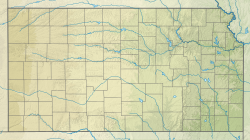| Wellington Formation | |
|---|---|
| Stratigraphic range: Early Permian(Artinskian) ~ | |
 Upper Wellington Shale excavated in the Smoky Hill River diversion channel at Indian Rock Park, Salina, Kansas  | |
| Type | Formation |
| Unit of | Sumner Group |
| Sub-units | Lower Wellington Member, Hutchinson Salt Member, Carlton Limestone Member, Upper Wellington Member |
| Underlies | Central-Western Kansas: (relative to the Sixth principal meridian)[1] East: Kiowa Shale Over: Pleistocene terraces West: Ninnescah Shale Northcentral Oklahoma: Hennessey Formation Garber Sandstone |
| Overlies | Nolans Limestone |
| Thickness | 500–700 ft (150–210 m) |
| Lithology | |
| Primary | Shale/mudstone/dolomite Salt/anhydrite/gypsum |
| Location | |
| Coordinates | 38°36′N 97°12′W / 38.6°N 97.2°W |
| Approximate paleocoordinates | 3°36′N 25°48′W / 3.6°N 25.8°W |
| Region | |
| Country | |
| Type section | |
| Named for | Wellington, Kansas |
| Named by | F. W. Cragin[2] |
The Wellington Formation is an Early Permian geologic formation in Kansas and Oklahoma.[2] The formation's Hutchinson Salt Member is more recognized by the community than the formation itself, and the salt is still mined in central Kansas.[3] The Wellington provides a rich record of Permian insects and its beddings provide evidence for reconstruction of tropical paleoclimates of the Icehouse Permian with the ability in cases to measure the passage of seasons.[4] Tens of thousands of insect fossil recovered from the Wellington shales are kept in major collections at the Harvard Museum of Comparative Zoology and Yale Peabody Museum of Natural History.[5]
- ^ "County Geologic Maps". Kansas Geological Survey. Retrieved 2021-11-13.
- ^ a b "Geologic Unit: Wellington". National Geologic Database. Geolex — Significant Publications. United States Geological Survey. Retrieved 2021-10-27.
- ^ "Geologic Unit: Hutchinson". National Geologic Database. Geolex — Significant Publications. United States Geological Survey. Retrieved 2021-10-27.
- ^ Cite error: The named reference
GilesEtAlwas invoked but never defined (see the help page). - ^ Beckemeyer, Roy; Hall, Joseph D (April 2007). "The entomofauna of the Lower Permian fossil insect beds of Kansas and Oklahoma, USA". African Invertebrates. 48 (1): 23–39. Retrieved 2021-10-27.

